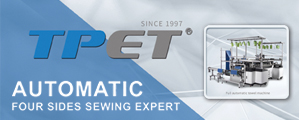Filament weaving: Slowdown of growth rate and rise of the domestic sales among steady development
Feb 19, 2019 | by
On October 31st, 2017, the CPC Central Committee Political Bureau organized a meeting to analyze and study the current economic situations. The meeting pointed out that the Chinese economy was faring well and rising steadily. The import and export growth was significant, foreign investments were steadily expanded, and the economic structure kept on optimizing. The economic operation situations of China’s filament industry in the first three quarters generally coincided with the national economic development. Below is a specific introduction:
Production stabilization of major industrial clusters
According to regional statistics of different industrial clusters, the chemical fiber filament output of seven places, including Shengze, Xiuzhou, Longhu, Siyang, Pingwang, Keqiao, Dafeng and Xiaohai would reach 16.264 billion meters accumulatively, which was 2.94% higher than that in the same period last year. The production-limit upgrade effects of Shengze, Xiuzhou, Pingwang, and so on were obvious, and emerging industrial clusters, like Siyang and Xiaohai, gradually increased their input. On the whole, the national chemical fiber filament fabric output maintained a steady growth.
Rapid growth of export
According to the statistics of China Customs, the export volume of China’s textile costume output reached 207.768 billion USD from January 2018 to September 2018, which was 4.61% higher than that of the same period last year, and the growth rate improved by 3.7% compared with last year and 1.3% compared with the first half of this year. Considering the product structure, the textile export volume was 89.291 billion USD, increasing by 10.45%, and the growth rate was 7.6% higher than that of the same period last year. Its percentage in the total output increased by 43%. Affected by the high cost, order and investment transfer of the weaving industry, apparels and accessories were faced with a growing export pressure, and the export volume totaled at 118.478 billion USD, which was just 0.59% higher than that last year. The export increase of textile products was significant, and the two were further differentiated. Seen from major export destinations, the export volume of Chinese textile product raw materials and textile apparels to the United States, EU, and Japan increased by 8.5%, 3.4% and 4.8%, respectively. The export performance of Chinese textile raw materials and apparels to countries along the “Belt & Road”, such as Vietnam, Indonesia, and Turkey, was also satisfactory, increasing by 30%, 21.6% and 5.7%, respectively, compared with that of the same period last year.
Recently, trade frictions waged by the United States have drawn wide attention from enterprises. Below is a analysis of Chinese filament fabrics exported to the United States. Major market data of filament fabrics for home apparel manufacturing exported to the United States showed that the United States imported an accumulative amount of products of the kind from different parts of the world from January to September 2018 was 6.96% higher than that of the same period last year, and the growth rate increased by 21.14%. Among it, the import volume of products of the kind from China was almost the same to that of last year and accounted for around 41.79% of the total, and dropped by 2.64% compared with the same period last year. According to the data of the United States Department of Commerce, the import drop of products of the kind from China to the United States was not exclusive. Similarly, the import volume from India and Turkey dropped by 1.64% and 1.99%, respectively.
Steady growth of the domestic sales market
The performance of the Oriental Silk Market showed that the soaring price of raw materials led to a weak increase in the chemical fiber filament price. However, on the whole, due to the original industrial cluster’s adjustment of the production capacity, the industrial transfer had not yet been fully completed, thus resulting in the short-term supply shortage, robust market demand, and slight increase of the price index.
Market confidence from the second quarter of 2018 reached a peak but dropped from the third quarter. Increase of the human cost, overwhelming pressure of environmental protection, and fluctuations of the international market environment — all these were causes of inadequate confidence, which also exerted an influence on the domestic economic environment. According to statistics of the National Bureau of Statistics, China’s residents per capita income from January 2018 to September 2018 actually grew by 6.6%; the actual consumption expenditure increased by 6.3%, which was higher than the per capita GDP growth rate by 6.2%. The consumption contribution rate was improved to 78%. Goods for everyday consumption constituted the major driving force for domestic market growth. Though China’s macroeconomy was faced with growing operation pressure, the general trend of steady development would not be changed, marked by the increasing national strength, stabilization of employment, comprehensive improvement residents’ income and consumption to the level of the moderately well-off society. All this would fuel the domestic demand of the textile and apparel market, and become a main driving force of the textile industry’s development.
Slowdown of the industrial economic growth rate
According to statistics of the National Bureau of Statistics, compared with the same period last year, the operating income of the chemical fiber weaving and processing Chinese enterprises above the designated scale totaled at 78.097 billion yuan from January 2018 to September 2018, which was 7.14% higher, and the growing rate dropped by 2.68%. The profits totaled at 2.751 billion yuan, increasing by 8.46%, and the growth rate fell by 11.16%. The profit margin was 3.52%, decreasing by 1.68%.
According to the data of China’s filament waving industrial clusters, compared with the same period last year, the operating income of five places, including Shengze, Xiuzhou, Siyang, Pingwang, and Heqiao increased by 10.13%, decreasing by 0.77%. The total profits increased by 8.25%, decreasing by 26.23%, and the profit margin reached 3.61%, dropping by 0.19%.
The economic indexes of China’s textile industry, chemical fiber filament weaving and processing industry, and five filament weaving industrial clusters (Shengze, Xiuzhou, Siyang, Pingwang and Keqiao) were generally stable and maintained a positive growth, but their growth rate showed different degrees of drop compared with the same period last year.
From March 2018, China’s chemical fiber filament weaving and processing industry slowed down its growth. However, the growth rate of management fees, financial fees and operating fees. Comparatively, enterprises’ profit margin is considerably steady.








